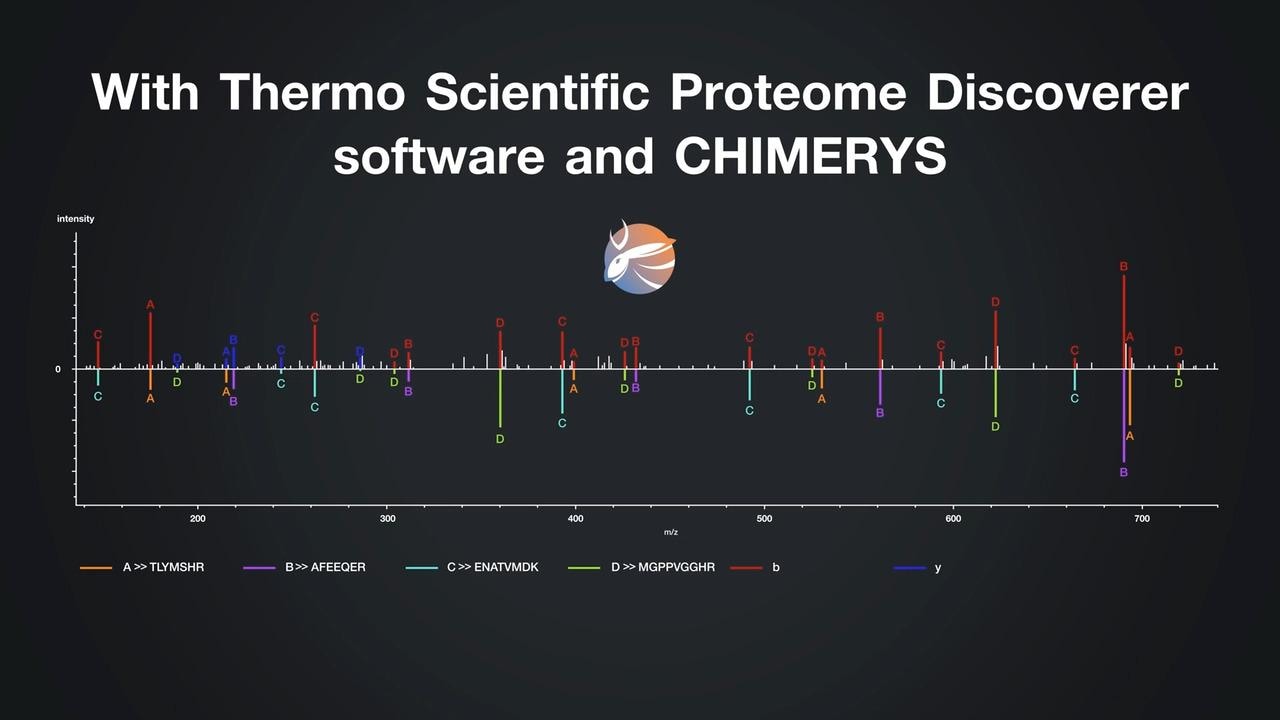Search Thermo Fisher Scientific


Comprehensive, extensible, and intelligent platform
Thermo Scientific Proteome Discoverer Software is the ultimate toolbox for protein research, offering customizable workflows tailored to the complexities of modern proteomics. It simplifies the identification and quantification of proteins in complex biological samples, supporting a wide range of workflows, including peptide and protein identification, post-translational modifications (PTM) analysis, isobaric mass tagging, and label-free quantitation (LFQ). It handles data from diverse acquisition methods, such as data-independent acquisition (DIA), data-dependent acquisition (DDA), and wide window acquisition (WWA), ensuring comprehensive coverage.
Advanced tools like INFERYS™ Rescoring and the CHIMERYS™ intelligent search algorithm by MSAID significantly increase identification rates, protein coverage, and the discovery of unique peptides and PTMs. The software enhances protein quantitation for isobaric mass tags and LFQ, supporting multiple database search algorithms and dissociation techniques. Whether analyzing glycopeptides, top-down proteomics, proteoforms, or MS-based structural biology like chemical cross-linking (XL-MS), Proteome Discoverer Software enables scientists to extract deeper biological insights from their data.
Discover how to transform proteomics mass spectrometry data into insights
Key benefits
| Customize your data analysis | Perform relative quantitation | Extensible workflow tools |
|---|---|---|
| Use the node-based workflow editor to customize your data analysis for maximum coverage and confidence. Integrate database search results from multiple search engines such as SEQUEST™ HT, MSPepSearch and third-party nodes including Mascot, MSAmanda, Comet, XlinX, Byonic™ from Protein Metrics, Thermo Scientific ProSightPD software and many more. Increase confidence in peptide identification and quantification using INFERYS Rescoring and enable a deeper mining of your DIA, DDA, or WWA data using the CHIMERYS intelligent search algorithm. | Measure and report the relative expression levels of isotopically labeled peptides for:
Confidently and efficiently interpret your data with integrated statistical and visualization tools for a faster time to meaningful results. | Build in customization, with the scripting and statistics insights nodes, while maintaining full integration into the Proteome Discoverer software framework to leverage visualization, statistical analysis, and biological interpretation tools to take your analysis to the next level. |
Comprehensive tools for proteomic studies
With a wide range of database search options and the ability to combine the output from multiple algorithms, Proteome Discoverer software increases confidence in results and decision making through cross-validation.
Complete sequence coverage and confident identification of post-translational modifications (PTMs) is realized with support for multiple dissociation techniques including collision-induced dissociation (CID), higher-energy collision-induced dissociation (HCD), proton transfer reaction (PTR), ultra violet photo dissociation (UVPD) and electron transfer dissociation (ETD) in tandem with built-for-purpose search engines.
Customizable data analysis workflows
Simplify data analysis with customizable workflows supporting multiple quantitative methods. Achieve experimental flexibility using TMT, TMTpro, or other isotopic labeling strategies, or opt for label-free quantitation techniques. Map quantitative data to biological information with study management and advanced algorithms for peak selection and peptide quantification, maximizing information extraction from proteomics studies.
Confidently and easily facilitate data comparison, exchange, and verification in compliance with data standards developed by the HUPO Proteomics Standards Initiative (PSI).

Manage, automate, process and share proteomics data
The Thermo Scientific Ardia Platform brings together scientific data and results into a centralized location, enabling users to interface intuitively with data, set up automated processing, and easily share results with colleagues and collaborators. Power your data analysis with the platform that brings your data, instruments, and applications together to deliver the future of proteomics workflows.
Featured resources
Rethink what is possible with Orbitrap Astral Mass Spectrometer
Go beyond. Unleash the power of proteomics
Explore a new dimension in proteomics quantitation
High-throughput, large cohort proteomic analysis
Proteome coverage and faster throughput for single-cell samples
Deeper proteome coverage and faster throughput
Order


















